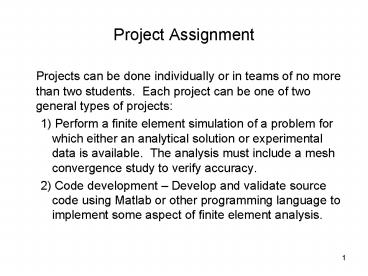Project Assignment - PowerPoint PPT Presentation
1 / 20
Title:
Project Assignment
Description:
The analysis must include a mesh convergence study to verify accuracy. ... Contact stresses between two cylinders (Hertzian contact) Elastic-plastic beam bending ... – PowerPoint PPT presentation
Number of Views:97
Avg rating:3.0/5.0
Title: Project Assignment
1
Project Assignment
- Projects can be done individually or in teams of
no more than two students. Each project can be
one of two general types of projects - 1) Perform a finite element simulation of a
problem for which either an analytical solution
or experimental data is available. The analysis
must include a mesh convergence study to verify
accuracy. - 2) Code development Develop and validate source
code using Matlab or other programming language
to implement some aspect of finite element
analysis.
2
Project Deadlines
- Submit proposal (approx 1-2 pages) via e-mail to
taggart_at_uri.edu by 3/27. Students submitting
ideas already submitted will be asked to submit
an alternate topic. Early submission of ideas is
therefore encouraged. Proposal shall include 1)
a brief description of the problem to be solved,
2) Discussion of background information including
relevant analytical solutions, experimental data,
and/or procedure to be implemented (be sure to
include references) and 3) preferred date of
presentation. - Progress reports showing preliminary results,
modeling questions, etc. are due Thursday 4/9.
Students are encouraged to see me with project
questions. - In-class presentations (including submission of
Powerpoint presentations) are planned for 4/23
4/28. Powerpoint presentations will be posted on
the course web page. - Project reports are due 4/29 (last day of
classes). Please submit both hard copy printouts
and electronic copies (MS Word or pdf) of your
report. The quiz during finals week will
include questions related to selected projects.
3
Potential Project Topics
- Axial and transverse shear stresses in laminated
beams plates under bending - Code development implement a particular element
formulation in Matlab (or other programming
language) - Comparison of available 3-D mesh generation
algorithms (Abaqus, Cosmos, Hypermesh) - Comparison of tetrahedral vs. hexahedral element
performance - Contact stresses between two cylinders (Hertzian
contact) - Elastic-plastic beam bending
- Elastic-plastic torsion
- Evaluation of column buckling formulas using 2-D
3-D solid elements (Euler / Johnson)
4
Potential Project Topics (cont.)
- Evaluation of transverse properties of fiber
reinforced composites - Free-edge interlaminar stresses in composite
laminates - Heat conduction (steady state or transient)
- Literature review and implementation of a mesh
generation algorithm - Study of shear coupling effects in composite
laminates - Thermal stress effects
- Torsion of non-circular shafts
- Vibrating string and/or plate
- Wave propagation
5
Potential Project Topics (cont.)
- Sources of other project ideas texts on
Mechanics of Materials (CVE 220), Machine Design
(MCE 301 / 302), Advanced Mechanics of Materials
(MCE 426), Mechanics of Composite Materials (MCE
440), Heat and Mass Transfer (MCE 448)
6
Step 4 Derive Element Equations
Chapter 6. Plane Stress / Plane Strain (cont.)
which will be used to derive
7
Derive Element Equations (cont.)
- Strain energy
8
Derive Element Equations (cont.)
- Potential energy of applied loads
9
Derive Element Equations (cont.)
- Potential energy
10
Derive Element Equations (cont.)
- Substitute
- to yield
11
Derive Element Equations (cont.)
- Apply principle of minimum potential energy
- To obtain
12
Derive Element Equations (cont.)
- Element stiffness matrix
13
Steps 4-7
- 4. Assemble global equations
- 5. Solve for nodal displacements
- 6. Compute element stresses (constant within each
element)
14
Example CST element stiffness matrix
15
CST Element Stiffness Matrix
- where
- B depends on nodal coordinates
- D depends on E, ?
- See text for details
16
Body and Surface Forces
- Replace distributed body forces and surface
tractions with work equivalent concentrated
forces.
fs
fb
17
Work Equivalent Concentrated Forces Body Forces
- For a uniformly distributed body forces Xb and
Yb
18
Work Equivalent Concentrated Forces Surface
Forces
For a uniform surface loading, p, acting on a
vertical edge of length, L, between nodes 1 and
3
19
Example 6.2
20
Example 6.2 - Solution
Element 2
Element 1































